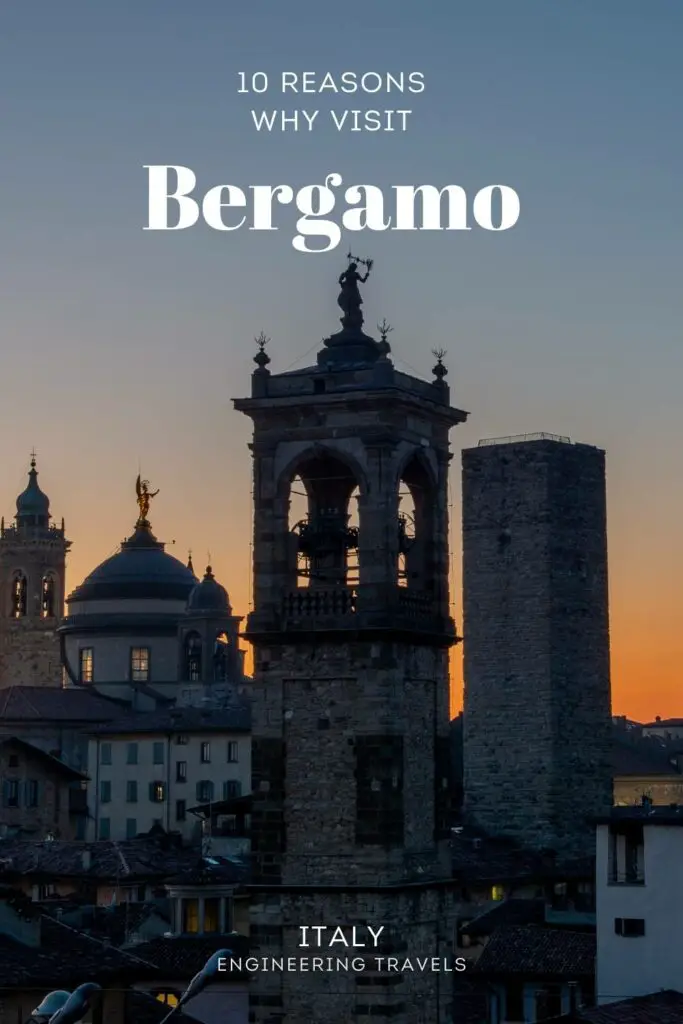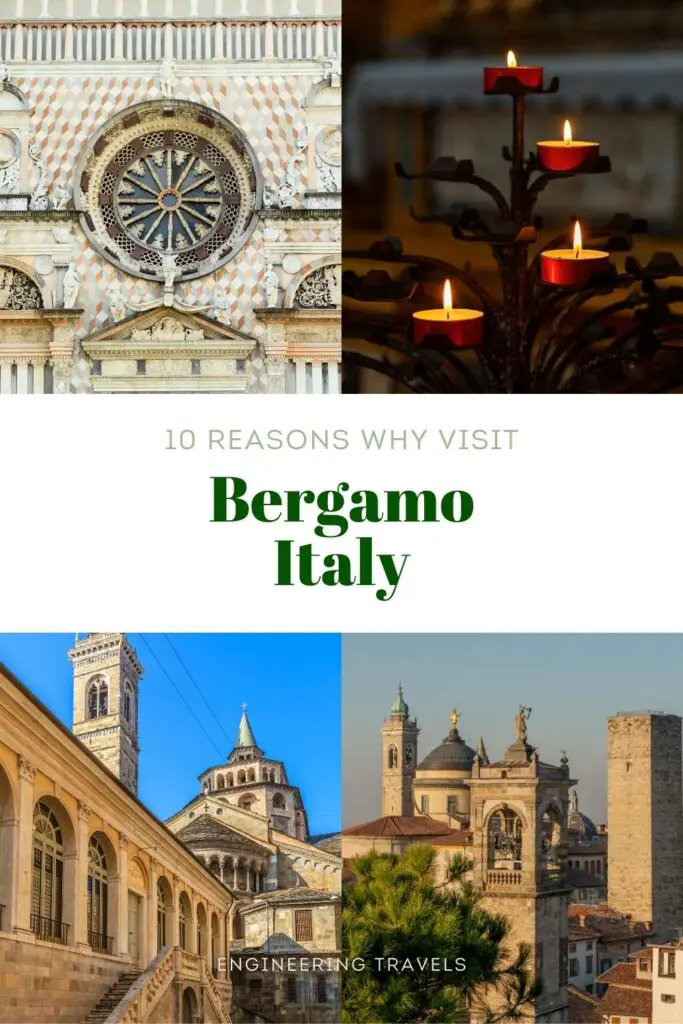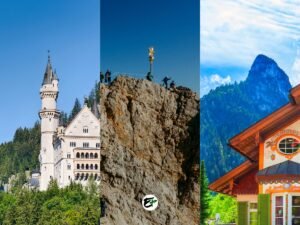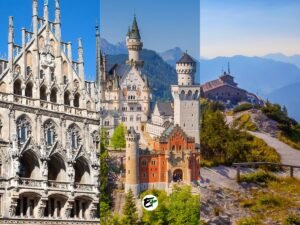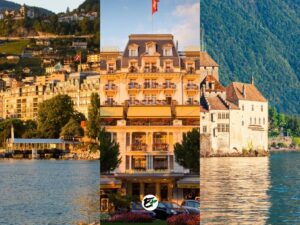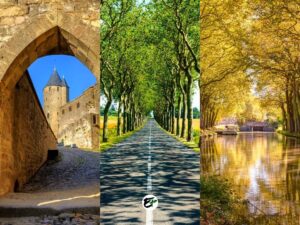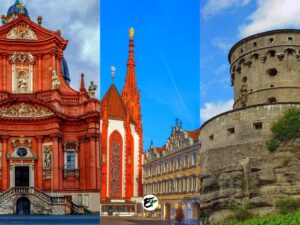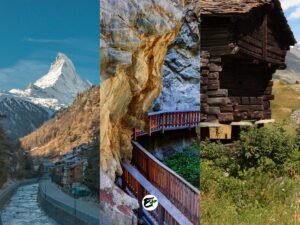Bergamo Travel Guide: 10 Things That Make It a Must-Visit
One of the perks of exploring smaller cities is the chance to have a more genuine experience. This is often because they aren’t as commercialized as their larger counterparts. You know, when a destination gets commercialized, the travel experience it provides often loses its authenticity and becomes more focused on profit-making.
When making travel plans for Northern Italy, and Milan is on your itinerary, I highly recommend considering Bergamo. Situated just 40 kilometers from the much-hyped Milan, this quaint city provides a more authentic taste of northern Italy that you might desire.
Nestled between the Alps and Milan, Bergamo is city that provides a unique blend of experiences. With its UNESCO heritage site, the Venetian Walls, and a host of other stunning architectural landmarks and scenic views, Bergamo is definitely worth exploring.
After exploring Bergamo, I can say with certainty that wanderers, history buffs, architecture lovers, and photography enthusiasts will not be disappointed by the beauty this city has to offer.
This post contains affiliate links. I may receive a tiny commission at no additional cost to you.
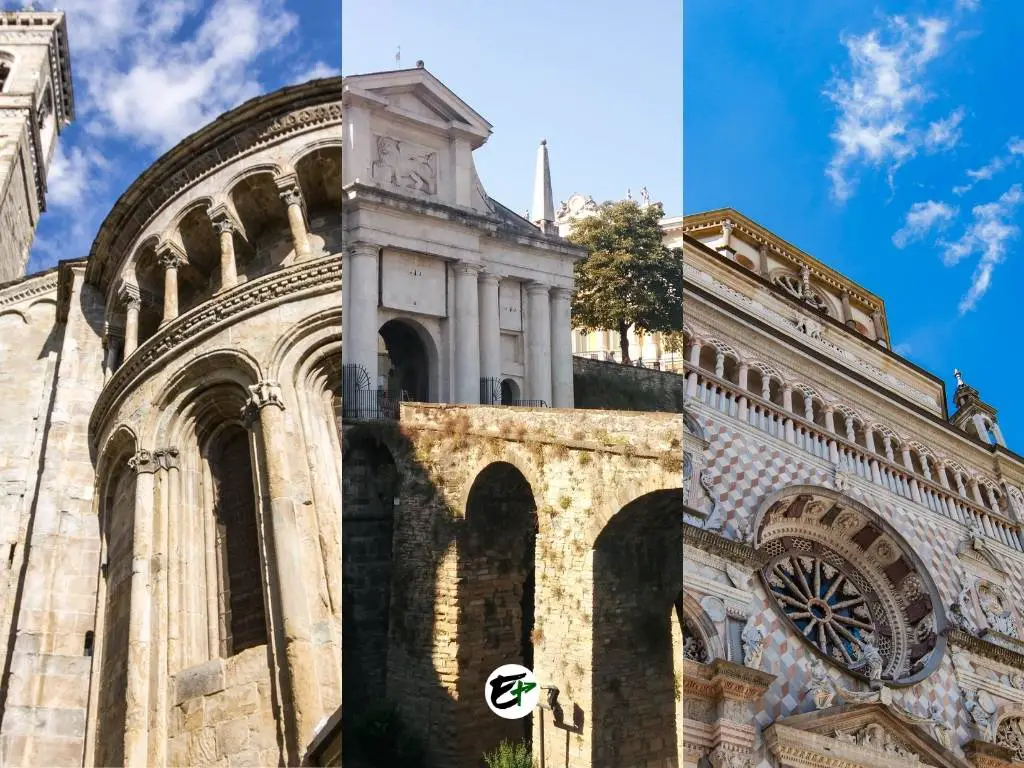
Use the table of contents to skip to topics.
Did you know? Bergamo has managed to avoid any sieges throughout its history. Its walls, landmarks, most of its buildings (particularly in the Città Alta) are still in their original state, which contributes to the city’s authentic charm. There’s so much more to learn about this city, so let’s explore why you should visit Bergamo.
If you need accommodation, here is where you can find the best hotel deals in Bergamo. Bus transfers from the airport/Milan, sim cards, tours, and private guides are available in GetYourGuide.
1. A Stunning Church in Bergamo: Basilica of St. Mary Major
Our journey through Bergamo begins with the Basilica di Santa Maria Maggiore, a truly remarkable sight in the city. The church’s interior beauty is so captivating that it’s become a key reason for visiting Bergamo. In fact, many visitors rank it as one of the most beautiful churches they’ve ever seen (including me)!
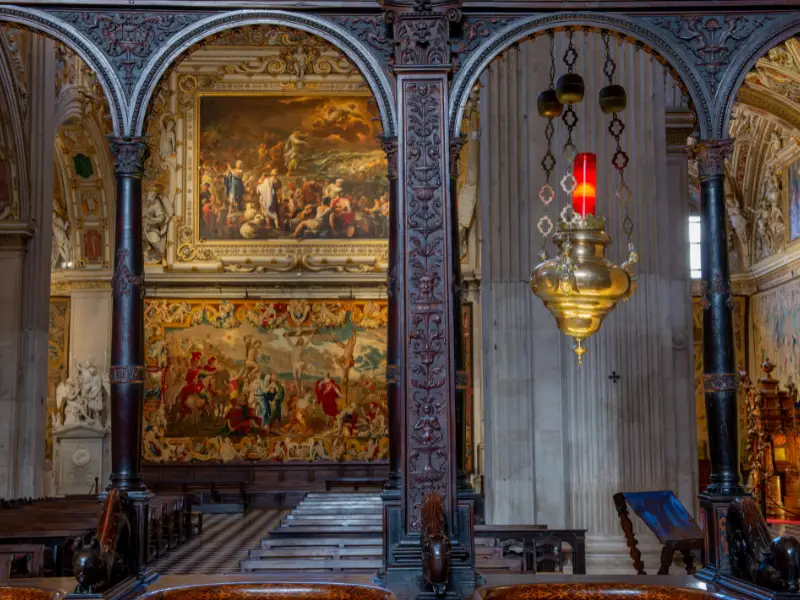
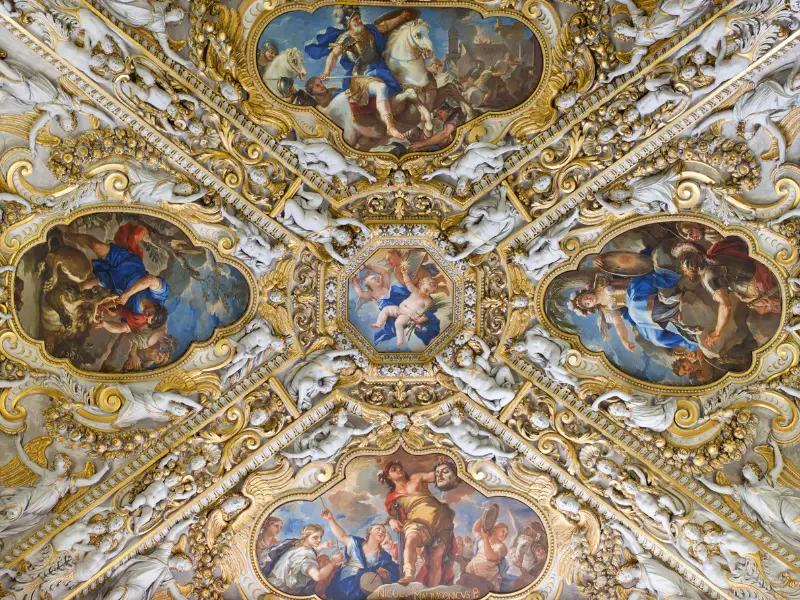
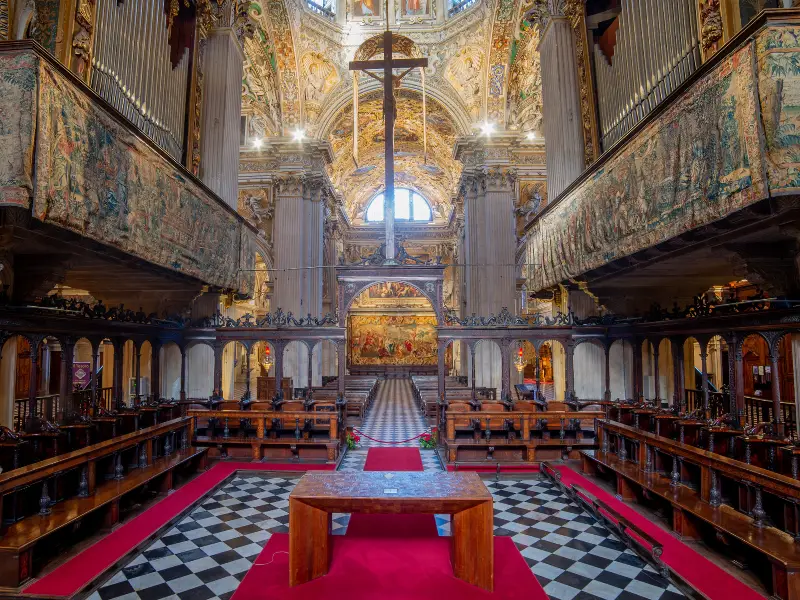
The Basilica of Saint Mary Major has a rich history that goes back over 900 years.
It was during those time that the people of Bergamo made a promise to the Virgin Mary. They built this church as a symbol of their gratitude for her protection during the plague that was devastating northern Italy. The Basilica of Saint Mary Major, located in the old town square, Piazza Vecchia, stands on the site of an earlier church.
While the entrance to the Basilica di Santa Maria Maggiore from the old town square is small and nearly unnoticable, the interior is a feast for the eyes. Inside, you’ll find the walls and ceiling filled with stunning tapestries, frescoes, and paintings. The intricate details are truly breathtaking, leaving no space untouched.
Inside the Basilica of Saint Mary Major, you’ll find artworks that narrate biblical tales, from the Crossing of the Red Sea to Mary’s life and Jesus’ Crucifixion. Artworks about the Last Supper and the Tree of Life are also present.
The frescoes, outlined in gold paint, offer a divine experience to visitors.
You can visit the Basilica of Saint Mary Major for a few Euros. It’s open from 8:30 am to 6:00 pm, Monday to Saturday, but do note that it closes for lunch from 12:30 pm to 2:30 pm. On Sundays, you can visit from 9:00 am to 6:00 pm, with a lunch break from 1:00 pm to 3:00 pm.
For more information about the basilica, please check the official website of Bergamo.
2. Bergamo’s Stunning Old-World Architecture: Colleoni Chapel
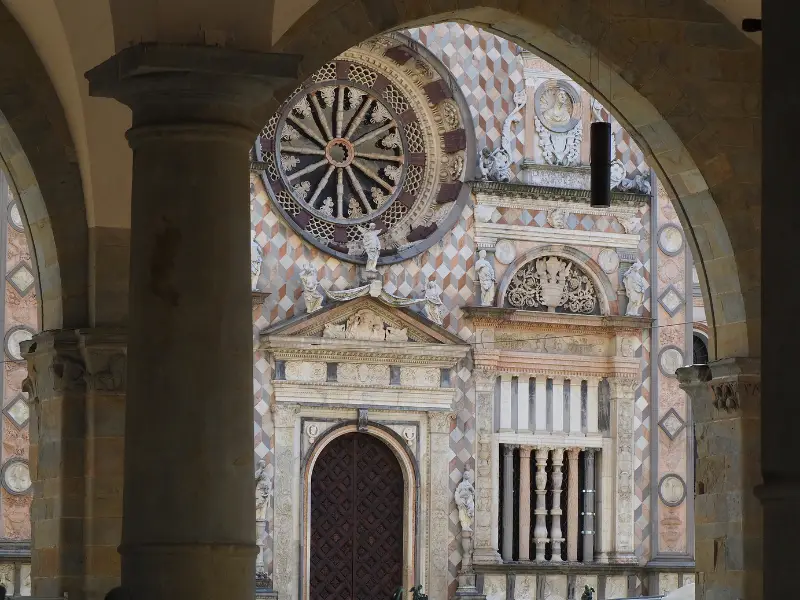
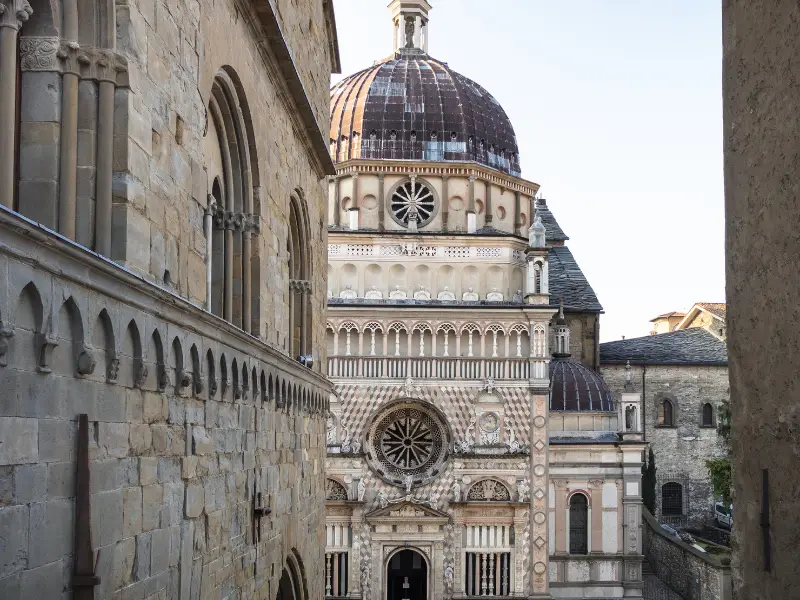
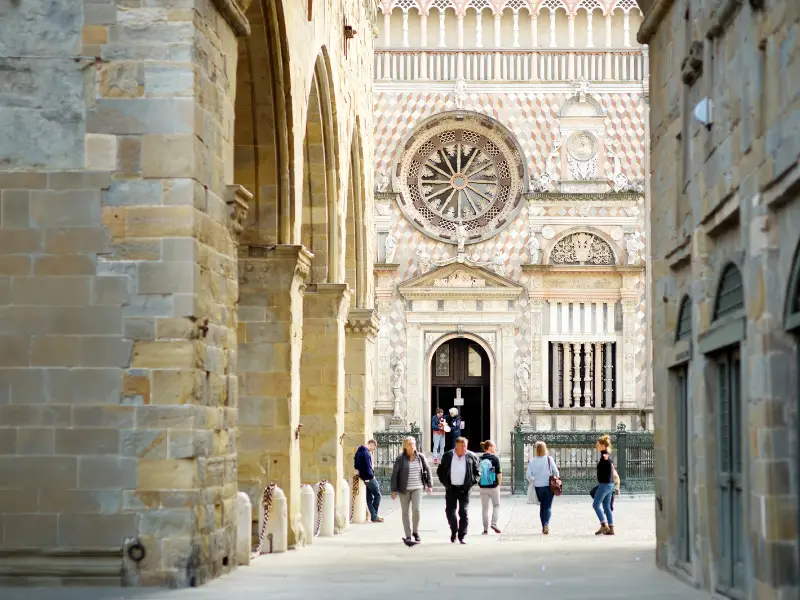
Another compelling attraction in Bergamo, right next to the Basilica of Saint Mary Major in Piazza Vecchia, is the Colleoni Chapel.
Known for its exquisite facade, this chapel and mausoleum is a sight to behold and a perfect spot for photography and exploring. It was constructed by Bartolomeo Colleoni, a notable individual from Bergamo’s mid-15th century history, and his daughter as a personal shrine dedicated to Saint Bartholomew, Saint John the Baptist, and Saint Mark.
Over time, the Colleoni Chapel has become something much greater than initially intended.
It’s now regarded as Bergamo’s most impressive structure and a major tourist attraction, representing the best of Italian Renaissance architecture. The facade is adorned with multicolored marbles arranged in detailed patterns that catch the eye.
And don’t forget to check out the rose window and the stone medallions of Julius Caesar and Trajan – they’re standout features of the chapel’s facade that you simply can’t overlook!
Step inside the Colleoni Chapel and you’ll be greeted by the sight of Bartolomeo Colleoni’s tomb, a grand altar, various artworks depicting scenes from the life of Jesus Christ, and much more.
According to the official website of Bergamo Tourism, entry to this chapel is free. It’s open for visitors from Tuesday through Sunday. The opening hours change with the seasons — from March to October, it’s open from 9:30 am until 6:00 pm, and from November to February, it’s open from 9:30 am until 4:30 pm. There’s also a lunch break from 12:30 pm until 2:00 pm.
For a more enjoyable visit, try checking the tours from the official website of the chapel.
Are you a fan of historical architecture and grand churches like I am? Then you should definitely consider visiting Paris, Strasbourg, and Lyon. These cities boast some incredibly impressive churches.
3. Bergamo’s Scenic Views: Campanone
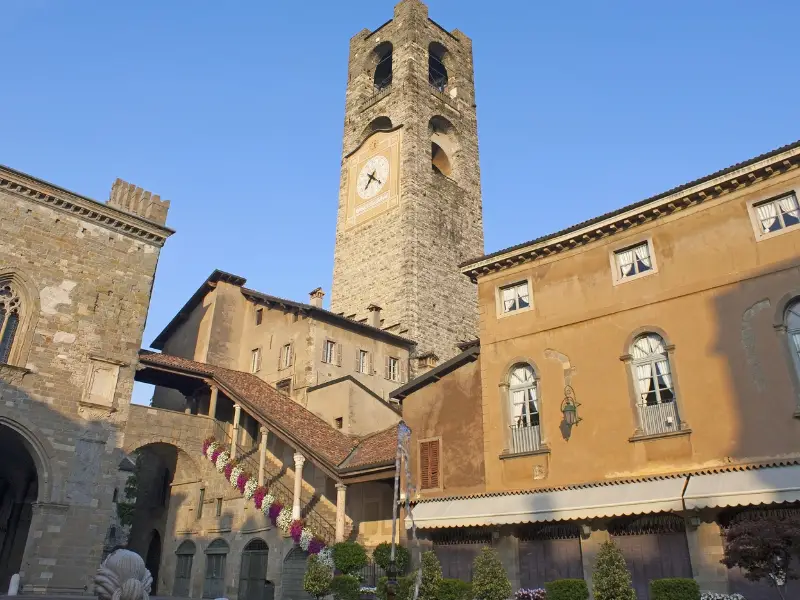
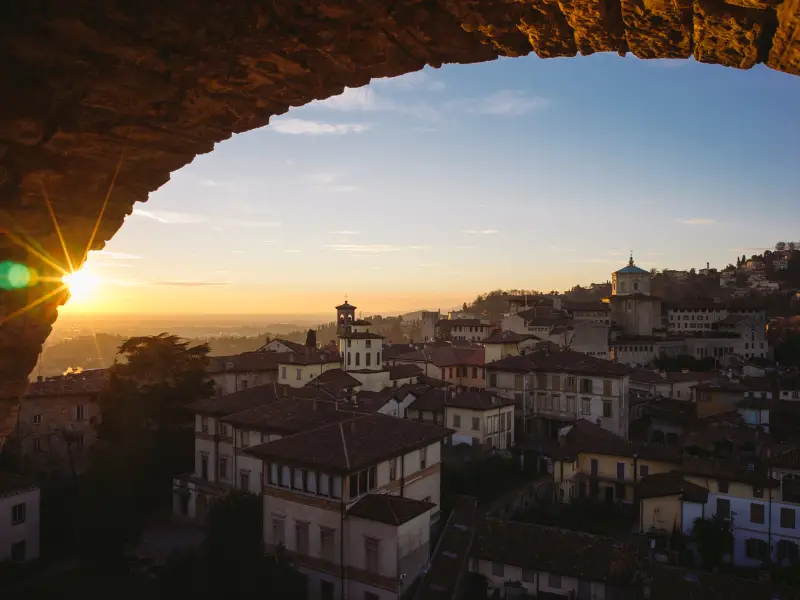
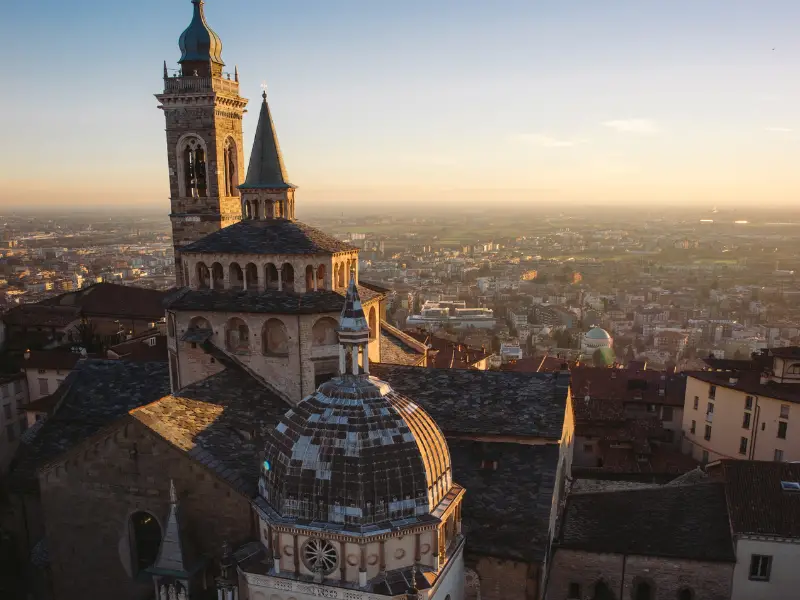
Another reason why Bergamo is worth a visit is the breathtaking view from Campanone, the town’s civic tower. You can climb up this tower for a vantage point that offers a sweeping view of the entire city, from Italy’s northern central plains to the rising hills and mountains of the Alps.
The best part? If you’re already in Piazza Vecchia, you won’t have to go far to reach Campanone – it’s right there in the same square! Just look for the tower in front of the Basilica of Saint Mary Major – it’s only a few steps away.
The Campanone stands tall at about 53 meters (173 feet). You can get to the top by either climbing a staircase of 230 steps or taking the elevator. But the panoramic city views aren’t the only thing you’ll find up there — there’s also Lombardy’s largest bell.
What’s even more impressive is that this bell is still in use, keeping a Bergamo tradition alive. Every night at 10 pm, the Campanone bell rings a hundred times in memory of when the city gates would close during Bergamo’s time under Venetian rule.
The sight from atop Campanone can be quite striking, particularly when the weather is hazy. From there, you can see more towers, the domes of nearby churches, and houses with tile roofs. It’s like stepping into a scene from a film or video game!
Access to Campanone comes at a cost of 5 EUR, but this also covers entry to Palazzo del Podestà. You can visit the tower from Tuesday through Saturday, from 10 am until 6 pm. For more information and updates about Campanone, you can visit the official website Bergamo museums. For a more insightful trip to Bergamo, don’t forget that there are available tours you can join!
4. A UNESCO Heritage Site in Bergamo: Venetian Walls
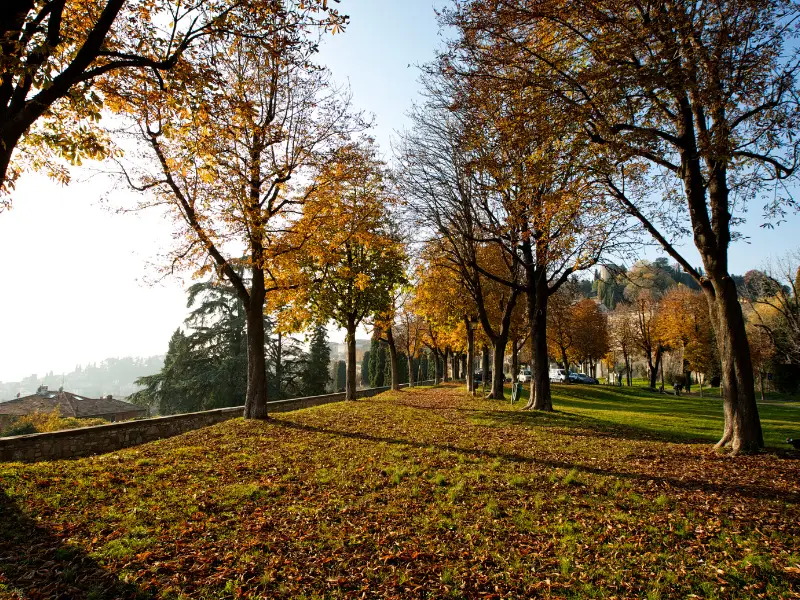
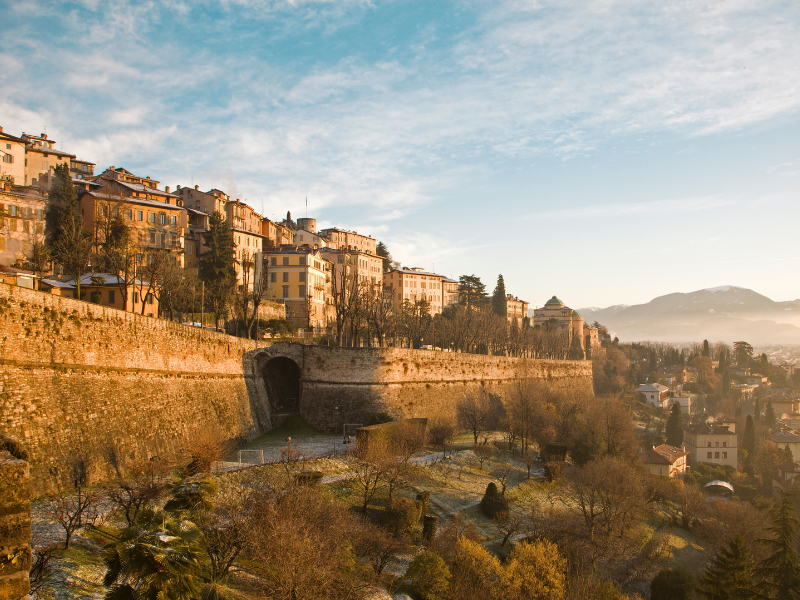
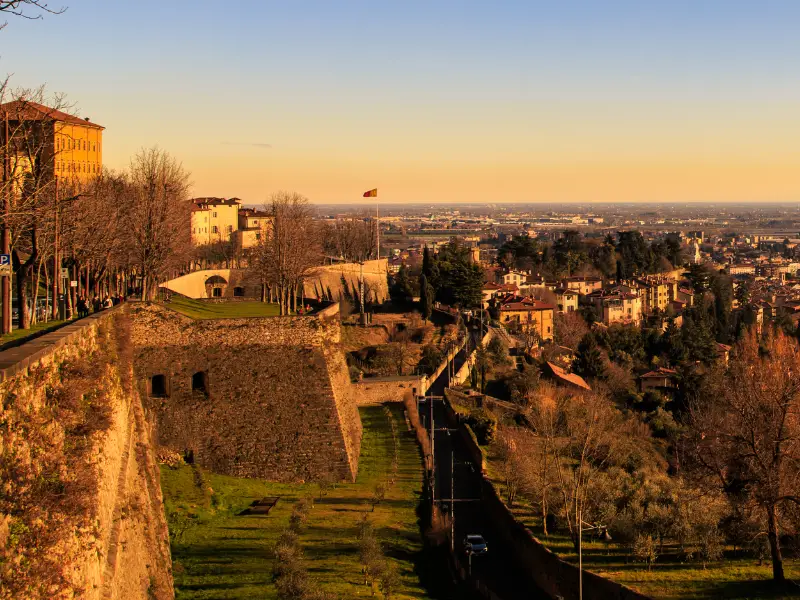
For me, visiting UNESCO heritage sites is one of the main draws of exploring a new city or country. These sites are often masterpieces of art or unique cultural creations that can leave you in awe. They hold universal value that makes them well worth the time and expense.
In Bergamo, you’ll find a UNESCO-recognized heritage site – the Venetian walls that encircle the old town. Spanning 6 kilometers or 3.7 miles, these walls are a journey back to medieval times.
Bergamo’s Venetian walls are quite a sight, boasting two armories, four gates, fourteen bastions, a hundred canon embrasures, and a network of underground passages and tunnels. If you’ve ever dreamed of stepping into a medieval movie or TV show, Bergamo is the perfect place to make that dream come true. Don’t forget to check out the casemates of San Giovanni and San Michele when you visit!
Constructed in the late 16th century, the walls of Bergamo served as a fortress to shield the city from potential invasions. Interestingly, Bergamo has been fortunate enough to avoid any battles, allowing the walls to remain untouched for centuries. What makes these walls unique is that they are largely in their original state. From atop these walls, one can enjoy picturesque views of the lower town.
It’s an ideal location for observing the sunset and taking time-lapse photos of the city from the golden hour to dusk and into the evening. You’ll find benches dotted along the walls, providing a comfortable spot to unwind and enjoy that magical hour in Bergamo.
5. Bergamo’s Time Transporting Gates: Porta San Giacomo

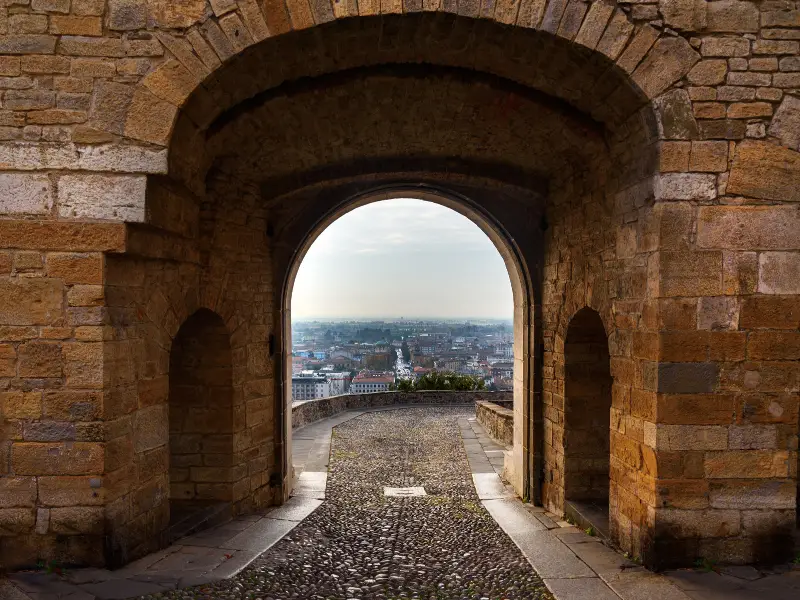
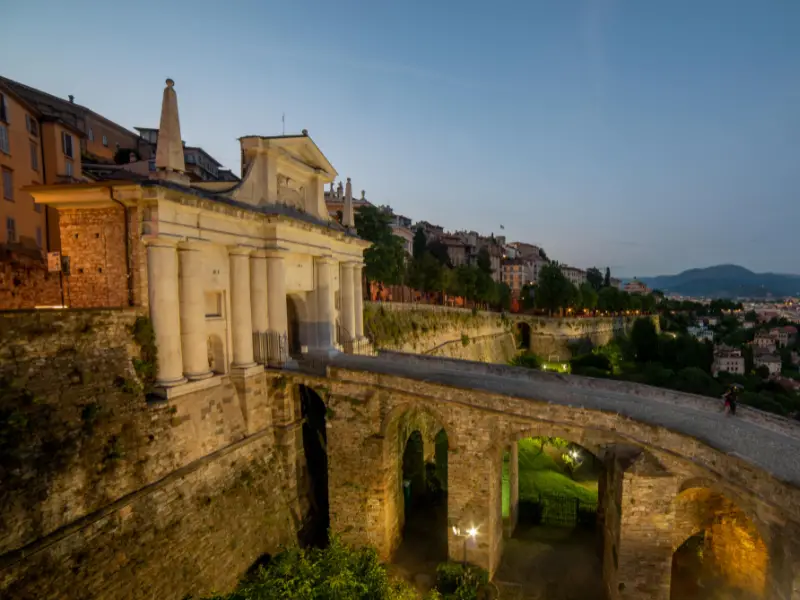
Porta San Giacomo, the most beautiful gate of the Venetian Wall, is a sight to behold and a compelling reason to visit Bergamo. This gate serves as the main entry point to Citta Alta and has been the route of choice for travelers from Milan for centuries. What sets Porta San Giacomo apart from the rest of Bergamo’s Venetian Wall is the unique material used in its construction.
Unlike the wall built from ordinary stone, Porta San Giacomo is made with white marble from Zandobbio’s quarries located 15 kilometers east of Bergamo. While its architecture is relatively simple, the white marble makes it a striking feature, particularly on a sunny day. Don’t miss the chance to see it glow golden during sunrise or sunset.
At night, Porta San Giacomo comes alive with lights in diverse colors, effectively transforming the gate into a canvas of hues. With a bit of luck, you could witness the projection of various images onto the gate, offering an incredible visual experience. This typically happens when there’s an event taking place in Bergamo.
Whether it’s day or night, Porta San Giacomo remains a picturesque highlight of Bergamo. Its high vantage point overlooking the lower town lends a certain romantic charm to the place. The presence of a masonry bridge spanning a moat further contributes to the overall medieval experience of exploring the area.
6. Bergamo’s Unique Attraction: Museum Inside a Bastion (Rocca Museum)

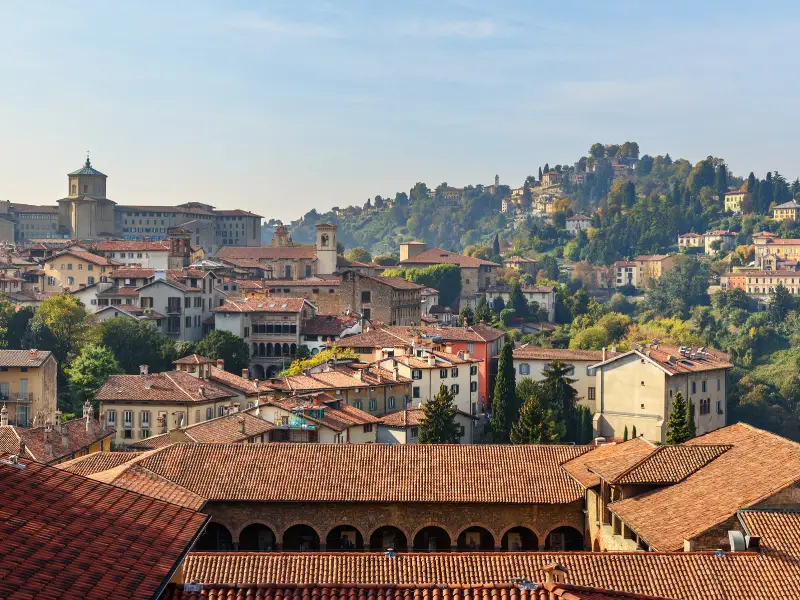
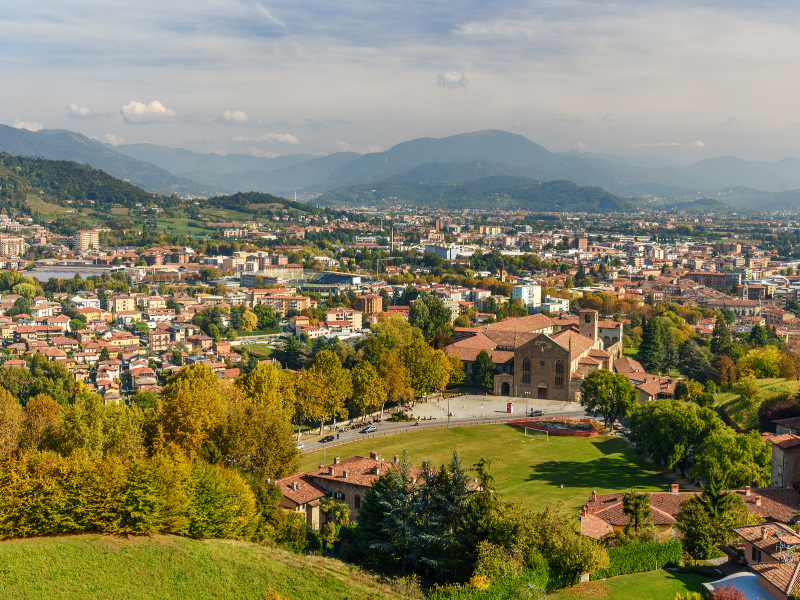
In addition to walls, bastions form an integral part of the defensive structures of a medieval city, and Bergamo has its fair share.
However, one bastion in Bergamo, known as Rocca, stands out from the rest and is a compelling reason to visit the city. Rocca is a 14th-century fortress situated to the east of Citta Alta, where remnants of Bergamo’s military prowess can still be found. Here, you can view cannons and tanks, explore a bombardier’s house and patrol walkways, and momentarily forget that you’re in the 21st century.
Rocca’s uniqueness lies in the museum housed within the bastion. The Rocca Museum provides not just a glimpse into Bergamo’s past, but also into a significant chapter of Italian history: the unification of Italy. Hence, it’s also known as the museum of the 19th century.
Interested in understanding how Bergamo transitioned from an old rule to being part of a unified nation? Step into the halls of the 19th-century museum, where you’ll find all the answers.
The exhibits range from everyday items used by locals to artworks and muzzle-loading rifles, offering a fascinating glimpse into history and the patriotism of the Italian people. This impressive fortress is a treasure box of information about the city and Italian history. During your visit, don’t forget to explore the gardens and walls within the complex, ascend the tower, and take in the breathtaking views.
Compared to the bustling town square, Rocca offers a less crowded environment. The area surrounding the bastion is perfect for a tranquil stroll and some quiet reflection after your museum visit.
Rocca is open to visitors every day except Mondays. The opening hours can change depending on the season, but generally, it opens at 10:00 am and closes at 6:00 pm, with a lunch break from 1:00 pm to 2:30 pm.
Check Bergamo’s website for more information, updates, and announcements.
If towns with medieval walls and stunning scenery like Bergamo appeal to you, then Carcassonne, Rothenburg ob der Tauber, and Aigues-Mortes should be on your must-visit list.
7. New Discoveries in Bergamo: Museum of Natural History
What makes Bergamo more interesting?
Nestled within the medieval town is a museum dedicated to prehistoric creatures, offering a delightful detour on your historical journey and sparking the curiosity of inquisitive minds. This place is known as the Museum of Natural History, conveniently located at Piazza Cittadella.
The Civic Museum of Natural Science Enrico Caffi (Museo Civico Scienze Naturali Enrico Caffi in Italian) houses an impressive collection of approximately 55,000 artifacts. These include everything from fossils to wax-preserved animals and plants. The museum’s standout exhibits are the skeletal reconstruction of a dinosaur and a massive mammoth figure.
And let’s not forget the room brimming with the heads of different deer and alpine animals. Strangely cool.
While the Civic Museum of Natural Science may not align perfectly with Bergamo’s medieval charm, it remains a compelling reason to visit the city. This is particularly true if you’re traveling with children, who are sure to be captivated by the exhibits. However, keep in mind that the information boards in the museum are in Italian.
To fully appreciate the descriptions of each displayed artifact and animal, it would be helpful to have Google Translate downloaded on your phone.
The Civic Museum of Natural Science in Bergamo operates on a seasonal schedule, with opening hours that can vary. However, you can generally expect it to open from 10:00 am onwards. It’s advisable to plan your visit to arrive before 5:00 pm. The museum is open every day, except for Mondays. For the most accurate opening hours, it’s best to check the museum’s official website.
The Civic Museum of Natural Science in Bergamo has irregular opening hours changing with the season. However, it should already be open from 10:00 am. I suggest that you come before 5:00 pm. It is open every day except Mondays. Check for announcements and exact opening hours from the museum’s website.
8. Beautiful Scenes in Bergamo: Skyline, Viewpoints, and Streets (Photos)
Bergamo, with its medieval charm, offers a landscape that seems to have leaped straight out of a movie or fairytale. The stunning architecture of the buildings in the town square, the panoramic views from the tower and bastion, and the quaint cobblestone lanes, arches, and old houses within the city walls are all photo-worthy.
Bergamo is undeniably picturesque and it also has a way of stirring the wanderlust within us. Here are some inspiring photos of Bergamo that will make you want to visit:
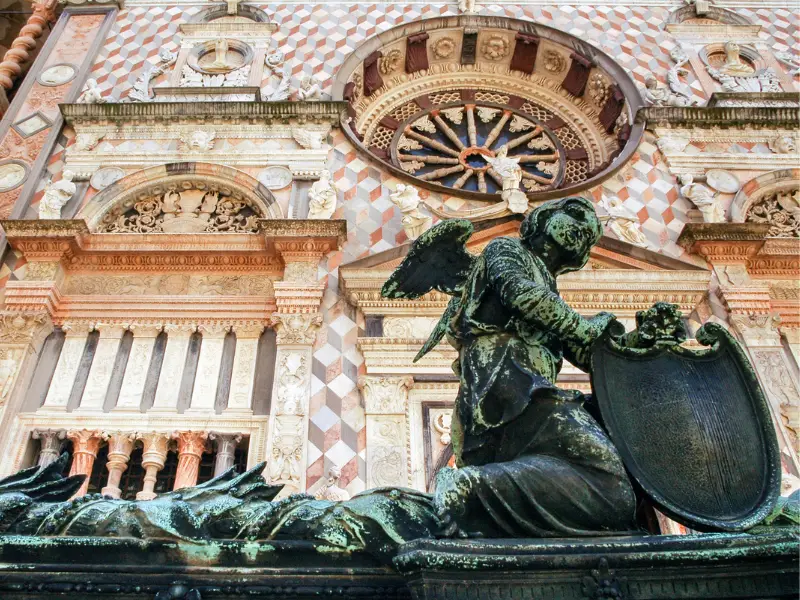
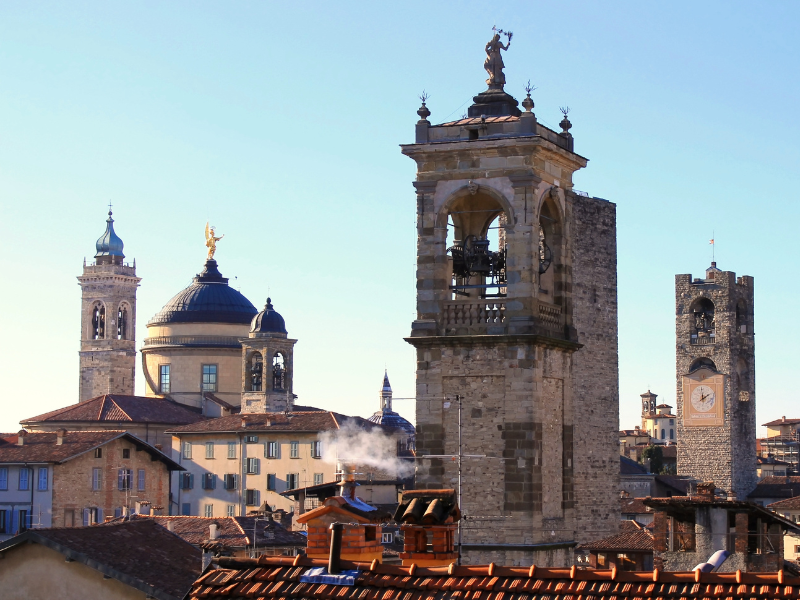
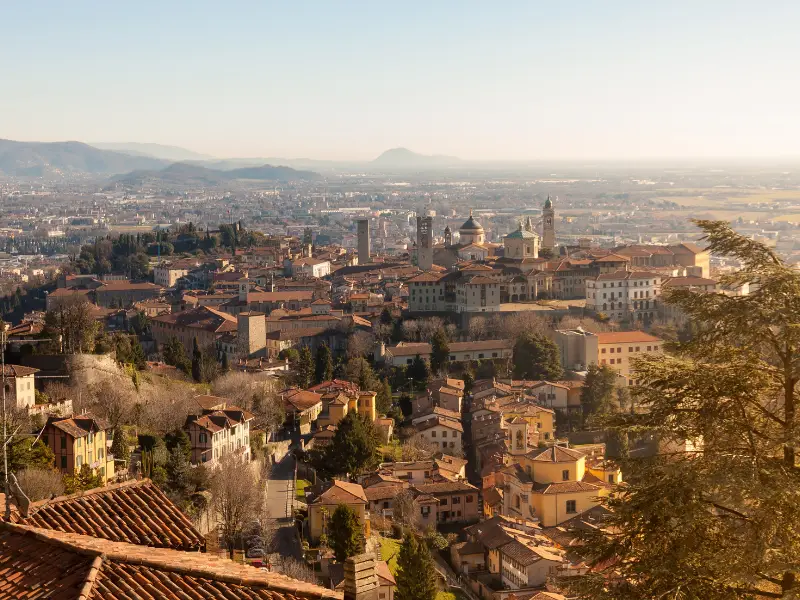
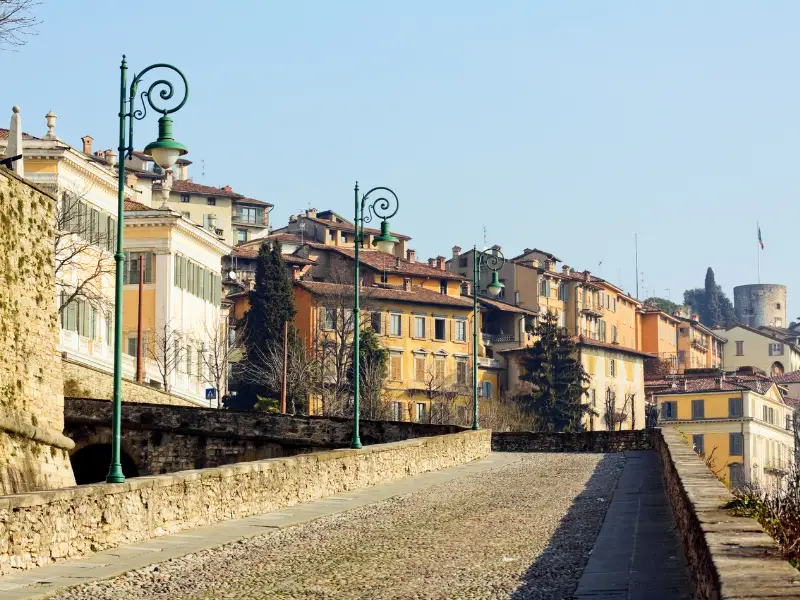
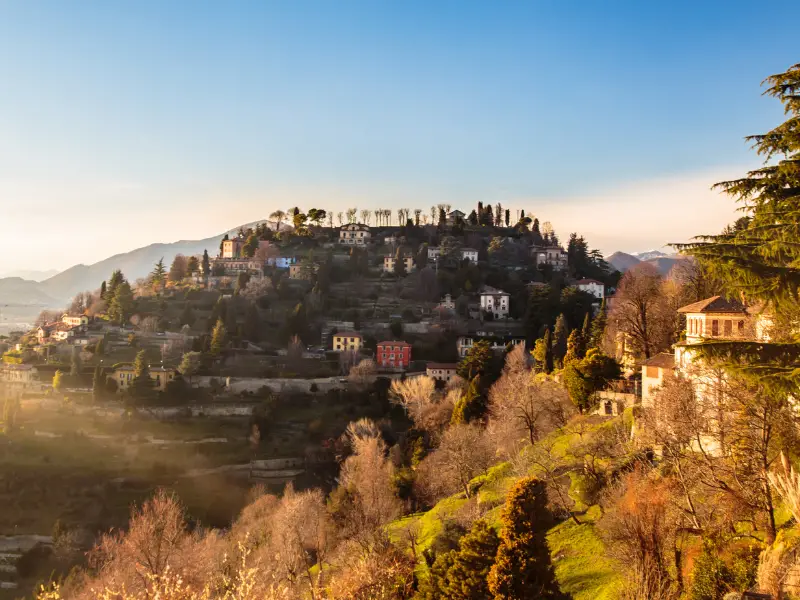
You can find and join city tours from here.
If you’re drawn to charming locations with stunning views, consider exploring the picturesque villages in southern France. My top recommendations? Don’t miss out on Moustiers-Sainte-Marie, Gordes, and Eze.
9. Local Cuisine of Bergamo: Polenta Taragna
Looking for another reason to visit Bergamo? Try the Northern Italian Cuisine. Unlike the dishes typically found in southern and central Italy, Bergamo’s cuisine features ingredients that thrive in cooler climates. Expect to find meat instead of fish and dairy products instead of olive oil in your meals here.
Some local specialties you might want to sample include Polenta Taragna, Casoncelli, and Scarpinocc. But among these three, Polenta Taragna is the most famous and what we can consider Bergamo’s food specialty.
Polenta Taragna is a beloved dish from the northern Italy. It’s a unique blend of yellow cornmeal and buckwheat flour, which creates a distinct flavor and texture. Just before serving, it’s often enriched with butter and cheese, resulting in a rich and satisfying meal.
The taste of Polenta Taragna is quite strong. The buckwheat flour gives it a darker color and a flavor that sets it apart from the more common “blonde” cornmeal polenta. It’s typically served as a main dish, often accompanied by salami or sausage.
Traveling to Bergamo for Polenta Taragna can be an exciting culinary adventure. The city offers an authentic taste of northern Italian cuisine, which stands out from the dishes you’d typically find in southern and central Italy.
In Bergamo, you’ll find Polenta Taragna at various local restaurants. “La Malga Osteria” located at Via G.B. Rota, 1, and “Polentone Citta Alta”, known for its polenta dishes, are great places to start. You might also want to check out “Sagra Della Polenta Taragna Di Stabello” located at Centro 12, 24019 – Zogno. Remember to check their official websites or contact them directly for the announcements and updates of opening hours (if there is).
Here’s a picture of Polenta Taragna:

You can find different dining experiences in Bergamo here.
10. The Accessible Location of Bergamo: From Milan, From Airports
One final reason to consider a visit to Bergamo is its convenient location. The city even boasts its own airport, Caravaggio Orio al Serio International Airport, which is less than 10 kilometers from the city center. To reach Bergamo Citta Alta from the airport, simply take bus #1. This will get you to the upper town of Bergamo in just 33 minutes.
Bergamo is a short distance from Milan and is often favored over Milan by many travelers. If you’re considering a visit to Bergamo from Milan, here’s what you need to do: Step one, board a train to Caravaggio Orio al Serio International Airport. Step two, catch bus #1 to reach Citta Alta. The entire journey should take approximately an hour and a half.
Bergamo can be visited on a day trip from Milan. You can find tours and day trips to Bergamo here.
When to Visit Bergamo
Bergamo may not be on everyone’s travel list, but it’s a city that promises fresh and authentic adventures! If Bergamo is on your radar, don’t rush! There are certain aspects you need to think about,
If you’re scratching your head about the best time to visit Bergamo for good weather, let’s clear things up. It’s important to note that Bergamo offers a balanced mix of attractions – half indoors and half outdoors. So, the weather can really shape your experience in this charming city.
For sun-seekers, the summer months are your best bet. July, in particular, sees temperatures soaring up to a balmy 87.2°F (30.7°C), while evenings are pleasantly cool at around 67.3°F (19.6°C). The summer season stretches from June 4 to September 11, with average daily temperatures consistently above 76°F (24°C). However, early June can be a bit rainy.
If you’re someone who enjoys a cooler atmosphere, think about planning your trip in April, September, or October. These months provide a more comfortable climate and fewer tourists compared to the busy summer period. Plus, if you’re looking to capture stunning photos of Bergamo’s vibrant cityscape, these months are your best bet.
Rain haters should note that May, June, July, and August are the wettest months. If you’d rather stay dry during your Bergamo adventure, consider visiting in July, October or January as these months see the least rainfall. You can check your favorite weather app for more information.
How Many Days in Bergamo
Bergamo, though small, is a city that’s brimming with attractions. You can easily get a feel for the city in a day.
Start your morning with a stroll around Citta Alta, taking in the architectural wonders like the Venetian Walls, Campanone, and the breathtaking Basilica of Saint Mary Major. In the afternoon, pay a visit to the Museum of Natural History and sample some local dishes. Don’t forget to capture a selfie at Porta San Giacomo during the golden hour.
If you’re coming from Milan, a day trip would suffice.
But if you want a more leisurely exploration of Bergamo, consider spending two days. This gives you ample time to visit other attractions like the Rocca Museum and enjoy tranquil moments at the Venetian Walls.
Where to Stay in Bergamo
Bergamo is split into two main parts: the Città Alta (Upper Town) and the Città Bassa (Lower Town). Each has its own charm when it comes to finding a place to stay.
The Città Alta is the city’s historic heart. Staying here means you’ll be surrounded by beautiful medieval architecture and close to major attractions like the Santa Maria Maggiore Basilica and San Vigilio Castle. It’s like stepping back in time! But keep in mind, being in such a historic area might mean a higher price tag for accommodation.
On the other hand, the Città Bassa is the modern part of Bergamo. Here you’ll find a variety of shops and more budget-friendly hotels. It might not have the same old-world charm as the Città Alta, but it offers more modern amenities.
If you’re looking for budget-friendly options, you’ll generally find more affordable accommodation in the Città Bassa. But don’t worry, there are also budget options in the Città Alta if you prefer the historic area.
You can find the best hotel deals in Bergamo here.
In terms of convenience, both areas have their perks. The Città Alta is perfect for history buffs as it’s home to many of Bergamo’s main attractions. The Città Bassa, with its variety of restaurants and modern facilities, offers a different kind of convenience.
And don’t worry about getting around — both areas are well-connected by public transportation, including a funicular that connects the upper and lower parts of the city.
How to Get Around Bergamo
Bergamo, a charming city in Italy, is quite easy to navigate. The city is small enough that you can explore most of it on foot. Walking from the Lower Town to the Upper Town can be a bit of a climb, but it’s a great way to soak in the local atmosphere.
If you’re not up for the walk, don’t worry! The city has an excellent public transportation system. The Azienda Trasporti Bergamo (ATB) operates the city buses, and the major lines run every 10 minutes during the day. In particular, Bus number 1 is a handy line for visitors as it runs from the train station along the main street axis of Città Bassa, and even goes to the bottom station of the funicular.
Speaking of which, taking the funicular is another great way to get around Bergamo. It’s especially useful for getting up to Città Alta (the old town).
As for renting a car, it’s not really necessary unless you plan to venture outside Bergamo or explore the lower town (Città Bassa). The old town (Città Alta) is best explored on foot due to its compact size and pedestrian-friendly streets. Plus, there are several restricted traffic zones (ZTL) in Bergamo, so driving can be a bit tricky.
Where to go next after Bergamo?
Currently exploring Bergamo and unsure of your next destination? You’re in luck! There are numerous exciting places to visit around this beautiful city. Given Bergamo’s proximity to the Alps, you have a wealth of options in both Switzerland and Italy for your next stop.
In Switzerland, there are great destinations in Switzerland that you can visit from Milan or Bergamo within (3-hour travel time or just within 2 to 3 train rides).
- Zermatt: Visit Zermatt for its unique blend of adventure and tranquility, offering endless excursion possibilities in a car-free zone. It is the town with the best views of the iconic Matterhorn.
-
Jungfrau Region: The Jungfrau Region is an ideal spot for nature lovers and thrill-seekers. It is home to three epic destinations.:
- Interlaken: Interlaken is a perfect spot for those seeking a mix of natural beauty and cultural experiences, offering numerous outdoor activities and attractions like Lake Thun and Lake Brienz.
- Lauterbrunnen: Known for its 72 thundering waterfalls and secluded valleys, Lauterbrunnen is an excellent spot for those seeking to immerse themselves in nature’s splendor and tranquility. Here is how you can spend 3 days in Lauterbrunnen.
- Grindelwald: Grindelwald is a fantastic spot for outdoor sports enthusiasts, offering stunning views of Mount Eiger, Mönch, and Jungfrau along with popular resort facilities for skiing, hiking, and climbing.
- Lucerne: Lucerne is a wonderful destination due to its rich history, beautiful lakeside setting, and proximity to excursion mountains like Rigi and Pilatus.
Looking to discover more of Northern Italy? We’ve compiled a list of places for you to visit, arranged in order of proximity to Bergamo and Milan, starting with the closest.
- Lake Como: Imagine cruising on the serene waters of Lake Como, taking in the breathtaking views of Villa Balbianello and Villa Carlotta. Don’t forget to visit the picturesque towns of Bellagio and Varenna.
- Cinque Terre: Picture yourself strolling through the vibrant, cliffside villages, soaking in the sun and savoring the fresh seafood. The scenic hiking trails offer panoramic views of the Mediterranean Sea.
- Verona: Step into the world of Shakespeare in Verona. Visit Juliet’s House, stand beneath her famous balcony and get lost in the romantic tale of Romeo and Juliet.
- Florence: Be awestruck by the architectural marvel that is the Cathedral of Santa Maria del Fiore. Explore Piazza Duomo and marvel at the intricate frescoes inside the cathedral.
- Rome: Walk through history in Rome. From the majestic Colosseum to the awe-inspiring Pantheon, Rome is a treasure trove of ancient wonders.
- Venice: Glide through the enchanting canals of Venice on a gondola. Visit Doge’s Palace and lose yourself in the city’s timeless charm.
- Trento: Discover science in a fun way at Muse Trento Science Museum. It’s an interactive experience that both kids and adults will enjoy.
- Bolzano: Immerse yourself in contemporary art at Museion. The museum’s striking architecture is a sight to behold.
- Cortina d’Ampezzo: Experience the thrill of skiing down the slopes of Passo Giau. The stunning mountain scenery will leave you speechless.
Save it on Pinterest.
